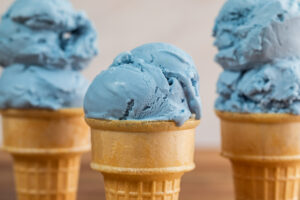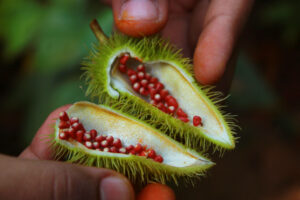How the Ice Cream Matrix or Formulation Affects Natural Color Performance
The matrix (alas…not the Matrix with Neo) – or the food ingredients and additives used in the recipe of your ice cream or frozen dessert – can affect the overall result of your product’s final color. Whether it’s the base type, fat content, or processing, this article will take you through some of these factors so you can get the best result using natural colors in your ice cream matrix.
While we’ll focus mainly on base ingredients of the formula in this article, check out our article on Color Selection for Fermented Dairy to see how additional aspects, like pH (e.g. the presence of lactic acid in frozen yogurt), can also impact your colors selection for dairy products
Coloring the Base
The main ingredients used to create ice creams and frozen desserts – such as dairy milk & cream or plant-based milks – may seem neutral in color but usually have intrinsic undertones. These may come from the source itself or from the previous processing steps, such as UHT or pasteurization, which tend to brown the bases through caramelization and Maillard reactions.
You can see in the image below that the background color of almond milk differs from that of a soy, coconut or oats beverages. The contributions of these undertones, can vary from yellow to tan or even to slightly grey-ish. So compensating for these may require the use of one or more natural colors with shades able to neutralize the undertone.
A yellowish undertone can often be neutralized by a bluish color, while a grey-ish undertone can be enhanced by the use of a warm hue. For example in the case of the grey undertones, you could utilize a blend of red beet plus a small amount of warm yellow/orange like beta-carotene or paprika to create a strawberry shade that would mask the grey tones of the original base.
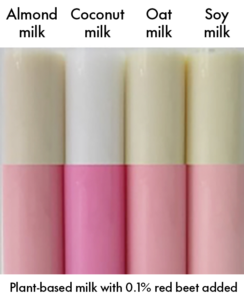
The fat content
The source of the milk is not the only factor that affects color. Fat content, which is responsible not only for the decadent creamy texture and the flavor carrying properties in frozen desserts, is also a main determinant of base whiteness.
As the dairy or non-dairy fat content is increased, the base gets whiter. The size of the fat globules contributes to the whiteness of the base because the smaller fat globules reflect more light. So, the fat content and the particle size reduction (due to homogenization) mean two things when coloring frozen desserts:
First, you will need to increase the dose of color to achieve the same color intensity, as white reflects a lot of light, diluting the perceived color. You can see this in action in the image below. As the fat content increases in the milk base, the color you see is lighter, even though it is used at the same dosage level in each type of base.
But at the same time the background whiteness allows for a cleaner and brighter coloring result, enhancing the identity of the hue you chose (the whiteness works as a compensating force for undesired undertones).
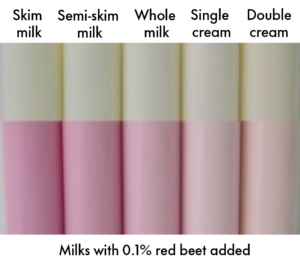
The Overrun and the Ice crystals
Sometimes taken for granted, one of the main ingredients in ice creams and frozen desserts is air. Air incorporation directly affects the density of the mix during the churning process and therefore modifies the perceived intensity of sensory attributes like flavor and sweetness, but especially color.
Additionally, small air cells reflect more light, contributing to the overall whiteness of the base. The same happens with ice crystals. The smaller the ice crystals (a desired attribute in ice creams), the greater the amount of light they reflect. The additives and ingredients used to control both crystal growth and aeration (sugars, gums, and emulsifiers) are therefore important factors to consider, as the expected overrun and the ice crystals size will affect the correct dosage of the color of your choice.
The image below shows an ice cream base prior to churning and freezing and after. The color appears brighter in the original base. You may have to overdose the color to account for this lightening in the final product.
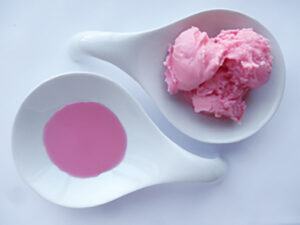
As you can see, most of the ingredients in your frozen dessert or ice cream matrix, as well as the process, are impactful on color selection. But most can be solved with the right dosage and color selection. If you work from the early design stages with the definitive ingredients and keep the above variables consistent as you scale up, the end result will be beautiful and predictable, and your end customers will love the way your frozen dessert looks.
No matter what base you’re working with or frozen treat you’re creating, we can help you pick out the best color for your application. Get started by requesting a natural colors sample kit for ice cream or contact us with your color questions.

